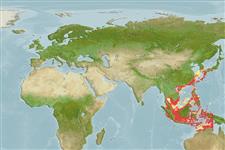Common names from other countries
Environment: milieu / climate zone / depth range / distribution range
Ecologia
Associadas(os) a recifes; estuarina; intervalo de profundidade 0 - 65 m (Ref. 111223). Tropical, preferred 26°C (Ref. 107945); 35°N - 15°S, 99°E - 137°E
Indo-West Pacific: from China, Japan and Korea to Philippines and westwards to the straits of Malaccca, also present in the Northern Territory, Australia. Tropical to subtropical.
Length at first maturity / Tamanho / Peso / Idade
Maturity: Lm 6.5, range 6 - ? cm Max length : 20.0 cm CW macho/indeterminado; (Ref. 343)
Carapace rough to granulose, regions discernible; front with 4 acutely triangular teeth; 9 teeth on each anterolateral margin, the last tooth 2 to 4 times larger than preceding teeth. Chelae elongate in males; larger chela with conical tooth at base of fingers; pollex ridged. Color: males with blue markings, females dull green.
Matures at about 1 year. Collected mainly by artisanal traps, trawls, beach seines, cylindrical wire traps, folding traps, pots, hop nets, drop nets, and sunken crab gill nets. In shallow waters, it is caught using beach seines, rakes, and dab nets. Sold in local markets (fresh or frozen) and for the crab-flesh canning industry. Most widely sold in markets of Southeast Asia, including the Philippines (Ref. 343). Maximum depth from Ref. 801. Immediate subtidal to a depth of 40 m (Ref. 801), on sandy to sandy-muddy substrates in areas near reefs, mangroves, and sea grass and algal beds (Ref. 343). Juveniles tend to occur in shallow intertidal areas (Ref. 343). Burrows in sand when disturbed; carnivorous and voracious predator (Ref. 801). Host to protozoans, helminths and crustaceans (Ref. 104981).
Members of the order Decapoda are mostly gonochoric. Mating behavior: Precopulatory courtship ritual is common (through olfactory and tactile cues); usually indirect sperm transfer.
Ng, P.K.L. 1998. (Ref. 343)
Status na Lista Vermelha da IUCN (Ref. 130435)
Status no CITES (Ref. 108899)
Not Evaluated
Not Evaluated
Perigo para os humanos
Poisonous to eat (Ref. 130554)
Uso pelos humanos
Pescarias: altamente comercial
FAO - Aquacultura: produção; pescarias: landings, perfil da espécie | FishSource | Sea Around Us
Ferramentas
Fontes da internet
Estimates based on models
Preferred temperature
(Ref.
115969): 18.1 - 29, mean 27.6 (based on 1324 cells).
Resiliência
Elevada, tempo mínimo de duplicação da população menor que 15 meses (K=0.1-3.11).
Prior r = 1.19, 95% CL = 0.78 - 1.78, Based on 22 data-limited stock assessments.
Vulnerabilidade
Low vulnerability (10 of 100).
